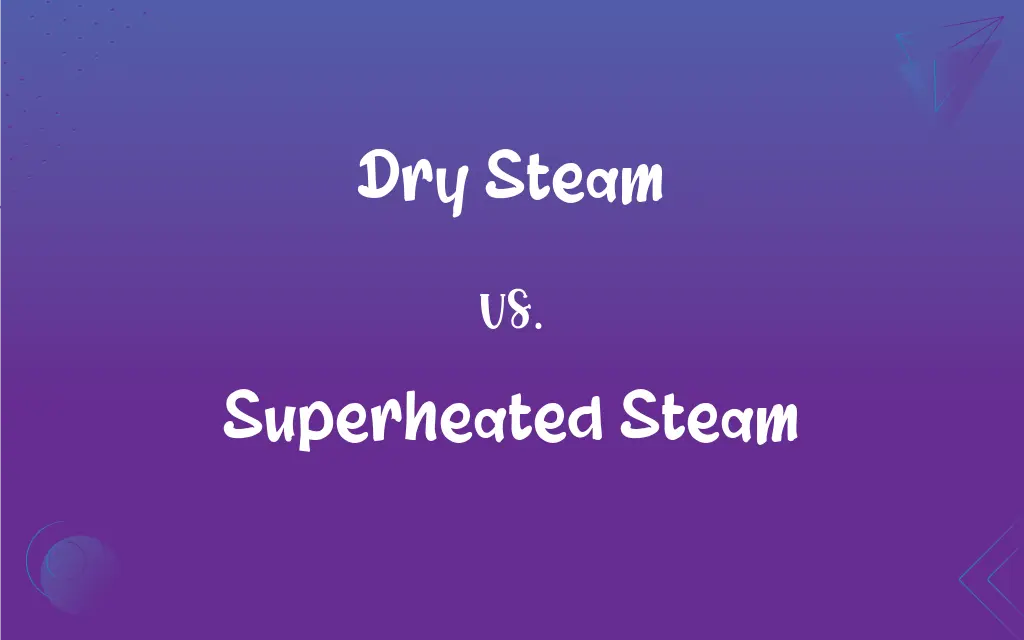Dry Steam vs. Superheated Steam: What's the Difference?
Edited by Aimie Carlson || By Janet White || Published on March 30, 2024
Dry steam is steam that contains no water droplets, while superheated steam is steam heated above its boiling point without increasing pressure.

Key Differences
Dry steam is a phase of steam that is at its boiling point, containing no water droplets within it. This form of steam is achieved when water is heated until it vaporizes completely into steam at the boiling point under a specific pressure. It is called "dry" because it is in a state where it is fully vaporized without any liquid water present. Superheated steam, on the other hand, is steam that has been heated to a temperature higher than its boiling point, without an increase in pressure. Once steam reaches its boiling point and becomes dry steam, additional heat can be added to take it into the superheated phase. This means that the steam's temperature is raised beyond its saturation temperature for a given pressure.
Dry steam is essential for applications where the presence of moisture must be minimized to avoid damage or to ensure the efficiency of the process, such as in turbines or sensitive manufacturing processes. Superheated steam is characterized by its ability to remain in the gaseous state even when it loses heat, up to a point. This property is particularly useful in industrial processes where steam must travel long distances through pipes; the superheating ensures that the steam does not condense into water during transit, maintaining its energy and temperature level.
Dry steam is used for its purity and efficiency in energy conversion processes, superheated steam is valued for its higher thermal energy content and its ability to transfer heat over longer distances without condensing. Each type of steam has specific applications where its properties are most advantageous, reflecting the importance of understanding the differences between dry and superheated steam in steam system design and operation.
Comparison Chart
Temperature
At boiling point, no higher
Higher than boiling point
Moisture Content
Contains no water droplets
Contains no water droplets
ADVERTISEMENT
Pressure Relationship
At a specific pressure for its temperature
Heated above its boiling point without increasing pressure
Application
Turbines, sterilization
High-temperature processes, long-distance steam transport
Energy Content
Lower compared to superheated steam
Higher due to additional heat beyond the boiling point
Dry Steam and Superheated Steam Definitions
Dry Steam
Vaporized water at its boiling point under specific pressure.
Dry steam cleaning removes dirt without chemicals.
Superheated Steam
Steam with higher energy content for improved process efficiency.
Superheated steam enhances the efficiency of thermal power plants.
ADVERTISEMENT
Dry Steam
Steam in its gaseous phase without water droplets.
Dry steam turbines generate electricity efficiently.
Superheated Steam
The phase of steam used for long-distance transport in pipelines.
Superheated steam travels without condensing back into water.
Dry Steam
Steam that has no liquid moisture content.
Dry steam is crucial for sterilizing medical equipment.
Superheated Steam
High-temperature steam used for thermal transfer processes.
Superheated steam is used in the drying section of paper mills.
Dry Steam
Fully vaporized water used in industrial applications.
Dry steam ensures the quality of the manufacturing process.
Superheated Steam
Steam heated above its boiling point without an increase in pressure.
Superheated steam drives turbines at higher efficiencies.
Dry Steam
The pure phase of steam used in power generation.
Dry steam plants utilize geothermal reservoirs.
Superheated Steam
Steam that remains gaseous even when cooling slightly.
Superheated steam provides consistent heat for chemical reactions.
FAQs
What is superheated steam?
Superheated steam is steam heated above its boiling point without increasing pressure.
Can dry steam carry more energy than water vapor?
Yes, because it's fully vaporized, maximizing kinetic energy for turbines.
Why is dry steam important in turbines?
It minimizes turbine blade erosion and maximizes efficiency by eliminating water droplets.
What is dry steam?
Dry steam is steam without water droplets, at its boiling point for a given pressure.
Can dry steam be used for cleaning?
Yes, it's effective for sterilization and cleaning without chemicals.
Does superheated steam require special equipment?
Yes, due to its high temperature, it requires materials that can withstand the heat.
How is dry steam produced?
By heating water until it vaporizes completely at a specific pressure.
What makes superheated steam ideal for long-distance transport?
Its ability to stay gaseous and retain heat over long distances without condensing.
Why is superheated steam used in power plants?
To increase the efficiency of steam turbines through higher thermal energy.
Why use superheated steam in industrial processes?
Its higher temperature improves efficiency and prevents condensation in steam lines.
Can superheated steam be used for heating?
Yes, its higher temperature makes it efficient for heating processes.
Can superheated steam freeze?
Theoretically, if cooled rapidly under certain conditions, but it's highly unlikely in practical applications.
Is superheated steam visible?
No, it's not visible because it's above the temperature where water condenses.
Is dry steam safer than wet steam?
Yes, in applications like sterilization, as it reduces the risk of microbial growth.
How does pressure affect dry steam?
It determines the temperature at which water boils into dry steam.
How do you measure the superheat of steam?
By the temperature increase above its boiling point at a given pressure.
Is dry steam always at 100°C (212°F)?
No, its temperature depends on the pressure.
What are the environmental benefits of using dry steam?
It reduces water usage and chemical discharge in cleaning and sterilization.
How does superheated steam improve turbine efficiency?
By providing a higher energy content and reducing condensation risks in the turbine.
What role does dry steam play in geothermal energy?
It's directly used to drive turbines in geothermal power plants.
About Author
Written by
Janet WhiteJanet White has been an esteemed writer and blogger for Difference Wiki. Holding a Master's degree in Science and Medical Journalism from the prestigious Boston University, she has consistently demonstrated her expertise and passion for her field. When she's not immersed in her work, Janet relishes her time exercising, delving into a good book, and cherishing moments with friends and family.
Edited by
Aimie CarlsonAimie Carlson, holding a master's degree in English literature, is a fervent English language enthusiast. She lends her writing talents to Difference Wiki, a prominent website that specializes in comparisons, offering readers insightful analyses that both captivate and inform.































































